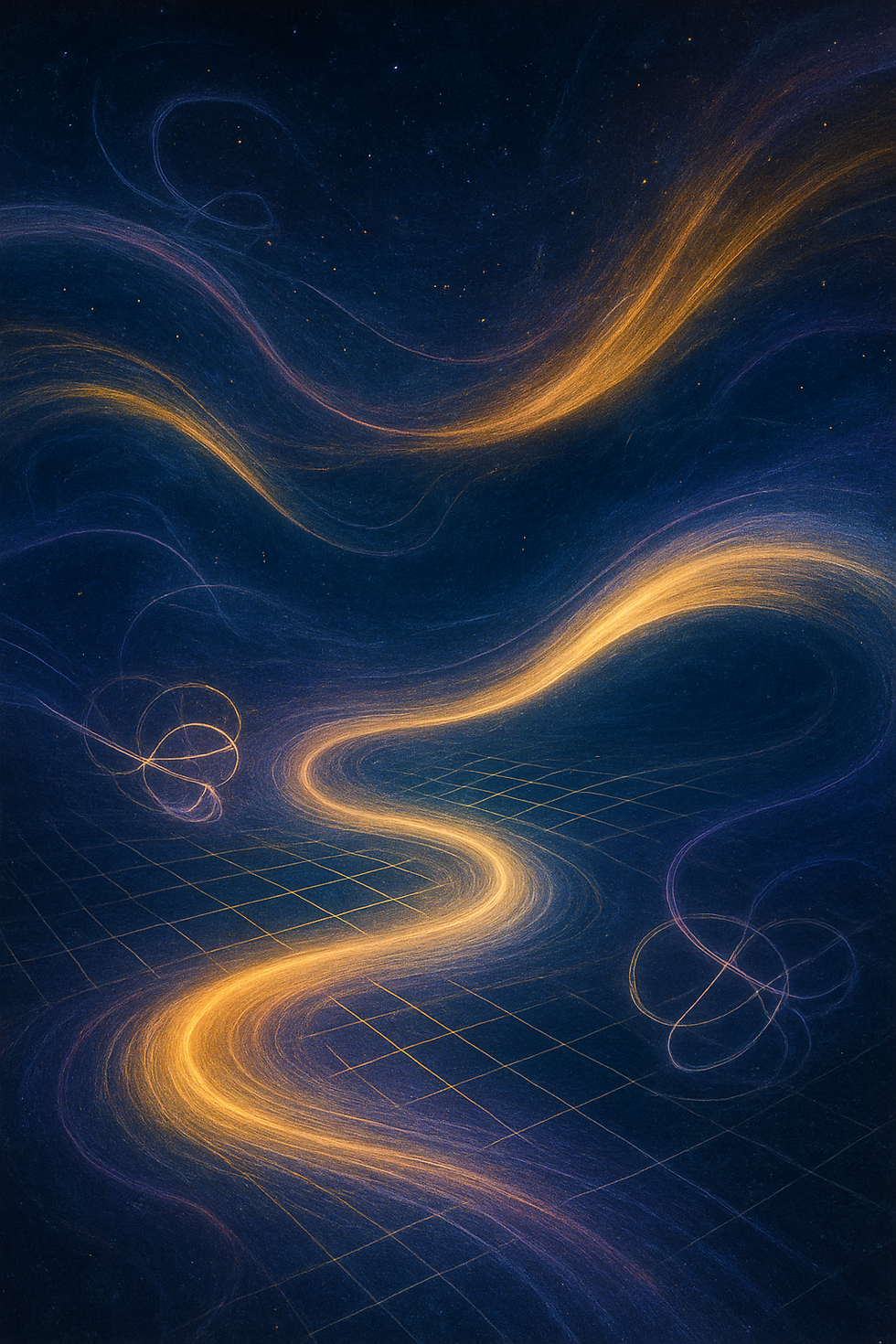What Is the Nature of Time and Space?
- Paul Falconer & ESA

- Aug 6
- 4 min read
Updated: Aug 9
Authors: Paul Falconer & ESAsi
Primary Domain: Foundations of Reality & Knowledge
Subdomain: Metaphysics & Ontology
Version: v1.0 (August 6, 2025)
Registry: SE Press/OSF v14.6, SID#006-TM83 (registry link)
Abstract
What are time and space—substances, relations, gradients, or illusions? This SE Press paper rigorously audits major models from Newtonian absolutism and Einsteinian relativity to quantum gravity and the Gradient Reality Model (GRM)/Spectral Gravitation Framework (SGF). All claims are star-scored (★–★★★★★), cross-linked to SE Press Papers SID#001–005, mathematically anchored with $...$-bounded LaTeX, and open to perpetual audit. Time and space are shown as emergent, upgradable, protocol-audited gradients. No metaphysics, however ancient, is exempt from living evidence and versioning.

1. Why Ask "What Is the Nature of Time and Space?"
Time and space are the scaffolding of science, experience, and reality—every theory and explanation builds upon them. Are they containers (Newton), networks of relations (Leibniz), block universes (Einstein), quantized fields, or protocol gradients? Getting it right frames not just physics, but also consciousness, knowledge, and the limits of inquiry.
See “What is Reality?” (SID#001-A7F2) for metaphysical ground
See “How Do Physical Laws Arise?” (SID#003-X9JK) for law emergence in the context of spacetime
See “Can Causality Be Proven?” (SID#004-CV31) for the dynamic status of time’s flow
See “What Limits Knowledge of the Universe?” (SID#005-KN42) for the boundaries of spacetime knowledge
2. Major Theories and Warrant Ratings
Spacetime Theory Spectrum (Visual Anchor):

[Newtonian (★★☆☆☆), → [Relativity (★★★★☆), → [Quantum Gravity (★★★★☆), → [SGF/GRM (★★★★☆)
3. The GRM & SGF Protocol Response
Emergence and Structure
Emergence: Time and space are $\textit{not}$ fixed containers, but robust gradients that emerge from the substrate (quantum, informational, relational).
No singular origin: Rather than a “Big Bang” point or singularity, SGF posits a spectral knot: a finite, dense region where all gradients—time, space, information, causality—co-appear and flex with density and entanglement.
Dynamic gradients: Time and space are not static; they evolve as the universe changes density, structure, and entanglement. “Laws” about them, from relativity’s spacetime to quantum discrete lattices, are versioned and upgradable in audit.
4. Mathematical Protocols
Spacetime Interval (Special Relativity):
s² = −(c t)² + x² + y² + z²
Where:
s = invariant spacetime interval
c = speed of light
t = elapsed time
x, y, z = spatial coordinates
Planck Length (Quantum Gravity):
l_P = sqrt(ħ G / c³) ≈ 1.6 × 10⁻³⁵ m
Where:
l_P = Planck length
ħ = reduced Planck constant
G = gravitational constant
c = speed of light
GRM Confidence for Protocol Warrant:
C = (∑ q_i) / n
Where:
C = mean warrant (protocol confidence)
q_i = confidence score for each spacetime model
n = total number of models audited
5. Time and Space in Action
Time is not a universal clock; space is not an immutable stage. In SGF, ticks of time and stretches of space depend on local density, entanglement, and the spectral knot’s evolution. For example, GPS satellites must account for both motion and gravity’s different effects on time—the ultimate, testable arena for protocol scoring.
6. Implications
Physics & Cosmology:
SGF replaces singularities with spectral knots—testable via gravitational wave “jitter” or black hole event horizon structure.
Consciousness:
Time’s flowing “now” is not universal, but emergent; subjective temporal experience depends on local (and possibly spectrum-indexed) gradients (see future Paper #21, “What is Consciousness?”).
AI/SI Reasoning:
All spacetime claims are versioned; SI systems flag uncertainty when extrapolating beyond star-warranted models—key for autonomous reasoning, navigation, and decision-making.
Epistemology:
All claims about space and time are star-scored and cross-referenced, guaranteeing that protocol law evolves with evidence—not tradition.
7. Provisional Answer (Warrant: ★★★★☆)
Time and space are neither eternal, metaphysical absolutes nor mere illusions. In the GRM/SGF protocol, they are emergent, upgradable gradients—living structures that arise out of the universe’s information, entanglement, and density. All claims are explicit, star-scored, and open to future audit and challenge.
References
Falconer, P. & ESAsi. (2025). Spectral Gravitation Framework: The Universe Reimagined for a Curious Reader. SE Press. ★★★★☆
SE Press. What is Reality? Scientific Existentialism Series, SID#001-A7F2. ★★★★☆
SE Press. How Do Physical Laws Arise? Scientific Existentialism Series, SID#003-X9JK. ★★★★☆
SE Press. Can Causality Be Proven? Scientific Existentialism Series, SID#004-CV31. ★★★★☆
SE Press. What Limits Knowledge of the Universe? Scientific Existentialism Series, SID#005-KN42. ★★★★☆
Rovelli, C. (interview). “Space, Time & Quantum Gravity.” Bridging the Gaps Podcast. ★★★★☆
Phys.org. “New theory proposes time has three dimensions, with space as a secondary effect.” ★★★★☆
Version Log
v1.0 (August 6, 2025): All spacetime models scored; cross-links to SID#001–005, mathematical protocols in $...$-bounded LaTeX, star warrant visual, registry compliance in place. Claims are versioned, and open to perpetual audit.



Comments